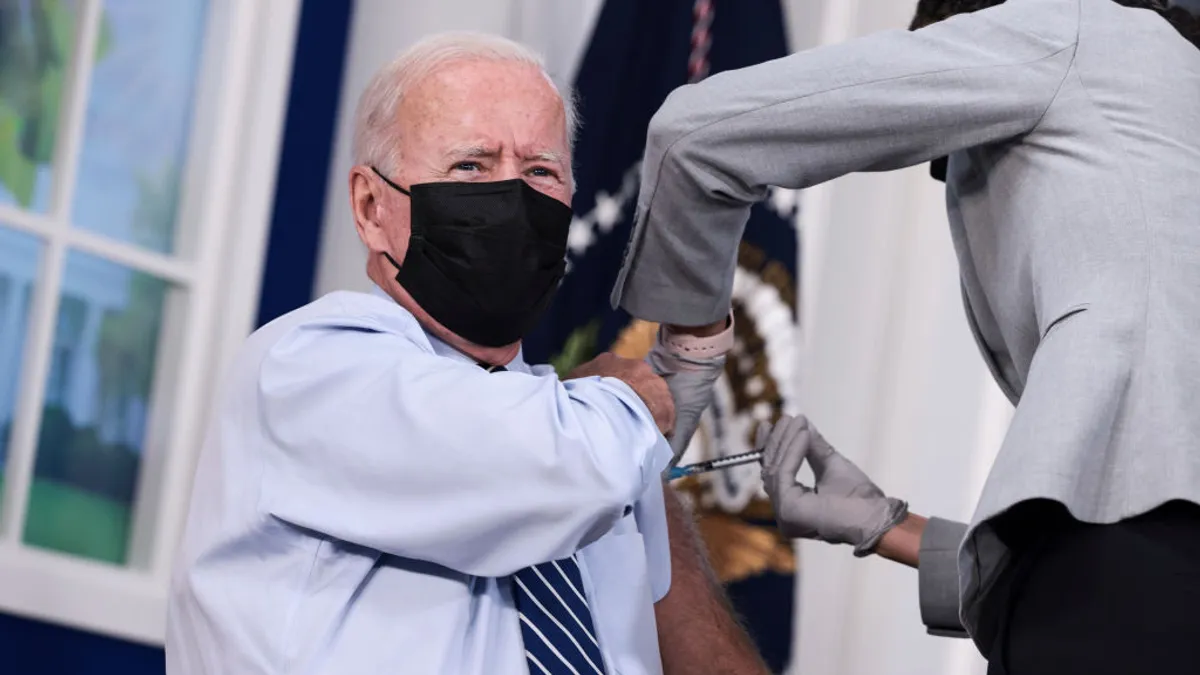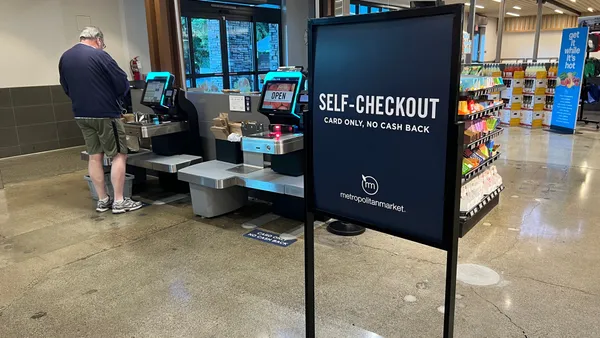Dive Brief:
- Employers with 100 or more employees will need to implement a COVID-19 vaccination requirement for their employees — and offer a weekly testing alternative to those who refuse or are unable to receive a vaccine — presumably by Jan. 4, 2022, according to an emergency temporary standard issued Thursday by the Occupational Safety and Health Administration.
- In determining whether they meet the 100-employees threshold, employers must include all employees across all of their U.S. locations, regardless of employees’ vaccination status or where they perform their work, per the ETS. Part-time employees do count towards the company total, but independent contractors do not. Additional sections of the ETS detail how the threshold should be determined in situations involving franchisees, multi-employer workplaces and staffing agencies.
- All covered employers are required by the ETS to bear the cost of providing up to four hours of paid time and reasonable paid sick leave needed to support vaccination, but where an employee chooses to remain unvaccinated, the ETS does not require employers to pay for the costs associated with regular COVID-19 testing or the use of face coverings. Some employees may be entitled to reasonable accommodation from their employer, absent undue hardship, due to a medical condition or sincerely held religious belief. Stakeholders have until 30 days after the date of the rule’s publication to submit public comments.
Dive Insight:
It is a monumental — if expected — development for workplaces throughout the U.S. But expect news on the emergency temporary standard to move fast as states file legal challenges against the Biden administration.
In September, 24 state attorneys general announced their intent to sue the federal government over the impending vaccination mandate. In their letter to the president, the attorneys general called the plan "disastrous and counterproductive," arguing that "at least some Americans will simply leave the job market instead of complying." In a tweet Thursday, Ohio Attorney General Dave Yost appeared to confirm the impending legal battle.
The Biden vaccine mandate dropped this morning. We will be challenging it in court, and like our case.
— Attorney General Dave Yost (@Yost4Ohio) November 4, 2021
Fwiw, I’m told the reg is 490
pages.
That is on top of laws and statutes in some states that potentially conflict with the ETS. Montana's state legislature passed a law earlier this year prohibiting employers from denying a person employment opportunities, barring a person from employment or otherwise discriminating against a person on the basis of vaccination status.
Last month, Texas Gov. Greg Abbott issued an executive order limiting vaccine mandates, including for private employers. And in Alaska, Gov. Mike Dunleavy issued an administrative order providing that "no state agency shall participate in, or use state funds or personnel, to further a federal vaccine mandate for employers."
Despite these wrinkles, some attorneys who spoke to HR Dive are not waiting for legal challenges to be resolved before advising employers on compliance measures. "I don't know that I would counsel a client to wait until that challenge is fully resolved," said Jill Lashay, shareholder at Pittsburgh-based Buchanan Ingersoll & Rooney, who added that preemption of federal law over state law may come into play.
In complying with the ETS, employers now have a litany of items to consider. Perhaps most importantly, employers must maintain a roster of each employee's vaccination status and must preserve "acceptable proof of vaccination for each employee who is fully or partially vaccinated."
The rule also specifies that the minimum requirements employers must implement regarding vaccination mandates do not apply to employees:
- Who do not report to a workplace where other individuals such as co-workers or customers or present.
- Who work from home.
- Who work exclusively outdoors.
That may seem straightforward, but employers will want to avoid treating remote work or flexible work arrangements as a "reward" for choosing to remain unvaccinated, said Brian Kropp, group vice president and chief of HR research at Gartner; "How you manage this remote worker exemption from a vaccine mandate is really tricky for employers."
Kropp added that the most "surprising" aspect of the ETS dealt with payment for testing, which OSHA effectively said may be passed onto unvaccinated employees. "It puts a lot of costs and pressure on individuals rather than companies if they choose to test," he said. Some employers may decide to pay for testing anyway, which may present another interesting dilemma — doing so may provide a "carrot" for employees that could compare favorably to companies that decide to pass the buck, but employers will also need to be careful that covering testing costs does not discourage unvaccinated employees from getting the shot, Kropp said.
Still, several states already have requirements in effect that employers pay for the costs of mandatory medical tests, said Devjani Mishra, shareholder at Littler Mendelson, while other states may require employers to reimburse workers for job-related expenses — a category under which testing could fall.
Additionally, mandatory vaccination policies may exempt employees for whom a COVID-19 vaccine is medically contraindicated, as well as those for whom a medical necessity requires a delay in vaccination, per OSHA.
In a statement issued Thursday morning, National Grocers Association President and CEO Greg Ferrara said "essential" businesses like food retailers need additional flexibility under the new requirements.
"We are concerned that this new mandate will add more stress onto the food industry at a time when there are acute worker shortages and significant supply chain challenges," Ferrara noted. "Additionally, trying to implement this mandate during the busy holiday season places even more pressure on retailers and wholesalers.
Beyond Thursday's announcement, the White House previously set a Dec. 8 deadline for federal contractors to get vaccinated.
Correction: A previous version of this story incorrectly described the employee count threshold OSHA will use to determine whether an employer is covered by the emergency temporary standard.














